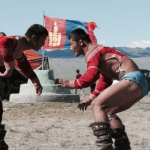 Mysteries
Mysteries  Mysteries
Mysteries  History
History 10 Surprising Stories About the Texas Rangers
 Humans
Humans 10 Philosophers Who Were Driven Mad by Their Own Theories
 Miscellaneous
Miscellaneous 10 Video-Game-Worthy Weapons and Armors from History
 Weird Stuff
Weird Stuff 10 Psychics Who Accurately Predicted Wartime Events
 The Arts
The Arts 10 Pieces of Art Inspired by a Broken Heart
 Health
Health 10 Science Fiction-Sounding New Medical Treatments
 History
History 10 Surprising Facts About the Father of Submarine Warfare
 Space
Space Ten Astonishing New Insights into Alien Worlds
 Weird Stuff
Weird Stuff 10 Bizarre Summer Solstice Rituals Still Practiced Today
 Mysteries
Mysteries Top 10 Haunting Facts About the Ghost Ship MV Alta
 History
History 10 Surprising Stories About the Texas Rangers
 Humans
Humans 10 Philosophers Who Were Driven Mad by Their Own Theories
Who's Behind Listverse?

Jamie Frater
Head Editor
Jamie founded Listverse due to an insatiable desire to share fascinating, obscure, and bizarre facts. He has been a guest speaker on numerous national radio and television stations and is a five time published author.
More About Us Miscellaneous
Miscellaneous 10 Video-Game-Worthy Weapons and Armors from History
 Weird Stuff
Weird Stuff 10 Psychics Who Accurately Predicted Wartime Events
 The Arts
The Arts 10 Pieces of Art Inspired by a Broken Heart
 Health
Health 10 Science Fiction-Sounding New Medical Treatments
 History
History 10 Surprising Facts About the Father of Submarine Warfare
 Space
Space Ten Astonishing New Insights into Alien Worlds
 Weird Stuff
Weird Stuff 10 Bizarre Summer Solstice Rituals Still Practiced Today
10 Jaw-Dropping Sports Facts You Might Have Never Heard Before
The sports world is filled with all kinds of strange stories and interesting facts. We’re not talking about memorizing a bunch of player stats or team numbers here, either. We mean real, weird, crazy, once-in-a-lifetime stories from the world of athletic competition. There’s no end!
Humans have been playing sports for pretty much as long as we’ve been alive, and the drive to compete is deep-seated and very real. The end result is great for sports fans, obviously, but even for the rest of us, there are enough zany tidbits to be pulled out of sports that can keep us entertained for ages. In this list, we’ll take a look at ten of those tidbits. Below, read through for the fascinating stories of ten sports facts you might’ve never heard before—and never realized you would be on the edge of your seat to know now!
Related: Top 10 Weirdest Professional Sports
10 Time Flies
If you’ve got 45 minutes, you’ve got time to break four world records. Okay, maybe not you (or us), as we’re all probably pretty average people who couldn’t sprint at top speed for a few hundred yards if our lives depended on it. But in less than 45 minutes, track superstar Jesse Owens really did break four world records. And he was pretty seriously injured while doing it!
The date was May 25, 1935, and Owens was a student-athlete at Ohio State University. Five days before that, on May 20, he slipped and fell down a set of stairs at his dormitory on the school’s campus in Columbus. But the Big Ten conference track championships were scheduled for the 25th regardless, and Owens wanted to compete. His coach considered having him sit out, worried he would injure his back even worse than it already was from the fall. But battered and bruised back be damned—Owens insisted on competing.
The world is now thankful that he did, too. In less than 45 minutes on the track, Owens participated in four consecutive events: the 100-yard dash, long jump, 200-meter dash, and 200-meter low hurdles. And he set world records in all of them! Obviously, no one else in track and field history has had that much success in that short of a time period. And it begs the question: What can YOU accomplish in 45 minutes?[1]
9 Tastes Like Chicken
Wade Boggs was one of the greatest hitters to ever play in Major League Baseball. His career numbers prove it: During an 18-year career from 1982 through 1999, Boggs was an All-Star 12 times. He got 3,010 hits in his lifetime, surpassing the vaunted 3,000-hit mark that few players have ever crested. And he ended his career with a stunning .328 batting average and a .415 on-base percentage—both insane numbers when compared to the average big leaguer.
For Boggs, though, all that success was because of one thing: chicken. Boggs was a notoriously superstitious person, even more so than the average baseball player. During his career, he became known as the “Chicken Man” because he refused to eat anything but chicken on the day of a game.
He ate chicken with every single meal before every single game for 18 years of play. He then successfully got on base at least once in 85% of those games, so perhaps he was on to something there. As the story goes, his wife had a cookbook in 1983 that contained a ton of chicken recipes. She made them, he ate them, he had a good year, and the rest was history!
Those weren’t Boggs’s only superstitions, either. He woke up at the exact same time on every game day, he ran his pregame sprints at exactly 7:17 pm every single night, and he made sure to take the exact same path out to the field from the dugout with zero deviation across every inning. Plus, when he got into the batter’s box with each of his 10,000-plus plate appearances, he drew out the Hebrew symbol for “life” in the dirt before stepping to the plate.
Ultimately, you can’t argue with success, though. The “Chicken Man” put up the numbers to earn his superstitious characteristics. For us, eating chicken every day might get a little old, but it clearly worked for Wade![2]
8 Endless Tennis, Anyone?
The longest professional tennis match in sports history lasted for more than 11 hours—and spanned three different days. It was played in 2010 at the iconic Wimbledon Stadium in England between American star John Isner and French tennis veteran Nicolas Mahut. In total, the match lasted exactly 11 hours and five minutes (that’s 665 minutes, for those of you keeping score at home) and spread out across three days due to several lighting and scoreboard-related issues at London’s iconic All England Club. In the end, Isner won 6-4, 3-6, 6-7, 7-6, 70-68. Whoa!
The match started on Court 18 on the afternoon of June 22, 2010. Isner and Mahut were able to complete four sets that afternoon, but by evening, the sun was setting, and there was no light to see, so officials halted the match. They planned to give Isner and Mahut the full day on the 23rd to finish their match—and they figured there would be plenty of time to do so. But sadly, there wasn’t. Each player held their serves in an unbelievably long fifth set when both natural light issues and scoreboard problems messed up the match once more.
See, the electronic scoreboard stopped working with the fifth set tied at 47-47. It hadn’t been programmed to keep score beyond that point in any match, and when Isner and Mahut got there, the All England Club hit a major hiccup.
So the players had to come back on a third day and continue their marathon match once more. Eventually, in the 137th game of the fifth set, Isner broke Mahut’s serve. And in the 138th game, Isner held on to his own serve to finally, thankfully, claim victory. The fifth set alone took over eight hours to play![3]
7 Breaking BIG Barriers
Jackie Robinson was the man who broke the color barrier way back in 1947, becoming the first Black Major League Baseball player. The pioneer broke through with the Brooklyn Dodgers and then went on to have a stellar Hall of Fame Career. After him, thousands of other Black baseball players rushed through to the big leagues. And many Latin American ballplayers from Mexico, the Dominican Republic, Venezuela, and other nations soon followed.
But it wasn’t until September 1, 1971, that another kind of history was broken: the first full lineup of Black and Latino players, top to bottom, on one team. On that day at Three Rivers Stadium in Pittsburgh, Pennsylvania, the formidable Pittsburgh Pirates fielded a starting nine with only Black and Latino players.
It was the first time a Major League franchise had ever done that, in fact. And while only 11,278 fans saw history made that day, the Pirates clearly were onto something bigger. They went to the postseason later that month and then won the World Series that October as the best team in the big leagues.[4]
6 Black and Yellow for All
Let’s stay in Pittsburgh for another fascinating fact, shall we? The steel industry city is the only one in America in which all three of their major professional sports teams have the same colors. The Pittsburgh Pirates (baseball), Steelers (football), and Penguins (hockey) all sport black and yellow as their primary colors. That’s kind of cool in and of itself and, certainly, a unique fact, considering no other city in the U.S. has that much uniformity. So what gives, then? Are Pittsburgh’s sports fans just really concerned about aesthetics and interested in making sure all their clothes match from season to season?
Well, not exactly. See, Pittsburgh’s sports teams purposely all chose the same primary colors for their uniforms because black and yellow are the city’s historic colors. When General John Forbes founded the city centuries ago in honor of British statesman William Pitt, the coat of arms that the Pitt family had used for ages was made up of black and yellow designs. Forbes took the black and yellow from that meaningful coat of arms and tried to make it the city’s aesthetic, too.
Then, when Pittsburgh was officially chartered as a city in 1816, officials made efforts to formalize that color scheme for the town. It has stuck ever since—and all three sports teams now honor that history with their modern looks.[5]
5 Rooting for the Steagles
We’ve done two straight interesting sports facts about Pittsburgh, so why not make it a hat trick and go for three? In 1943, World War II was in full swing, and men were serving and dying in brutal battles in both the European and Pacific theaters. Because of that, many parts of the American homeland were seriously under pressure to get by with less labor, fewer supplies, and severely restricted war rations. Women stepped into the workforce, of course, but there was one spot that women weren’t able to go and were never asked to: the world of professional football.
In the fall of 1943, the Pittsburgh Steelers and the Philadelphia Eagles were both hoping to play at least part of a pro football season. They intended to give fans in their respective Pennsylvania cities some respite from the weariness of war. There was just one major problem with that: Both teams had lost so many men to military service (and, sadly, death in battle) that neither one of them could field a full club. So they decided to join forces—literally.
Instead of playing independently of each other as the Steelers and Eagles, the two clubs became one in the fall of 1943. And yes, if you didn’t already figure it out, they did change their name to the “Steagles.” It wasn’t the prettiest mascot, but it did the job. While the two coaching staffs had to work a little harder to get on the same page with each other, they had a combined season and gave people in their two towns the inspiration they needed. And they won!
Well, they didn’t win a championship or anything, but the Steagles finished the year with a 5-4-1 record. That was the first time the Eagles ever won more games than they lost after first being founded in 1933, so the combo proved to be a good luck charm there![6]
4 Keep It Dark and Covered, Please

Umpires who work games officiating in Major League Baseball are bound by strict codes of conduct on the field. Where they position themselves to call plays, how they give signals to their other umpiring crew mates and the game’s viewers, and how they direct the pace of play on the field are all very much tightly controlled. They train for years to be able to do the job at a high level, often spending half a decade or more in the minor leagues before only the very best few will be given a shot at a job in the big leagues. So it makes sense that the cream rises to the top, so to speak, and only the very best, brightest, and most by-the-book umpires succeed in the highest levels of pro baseball.
But here’s a crazy and often unknown part of their job: They have very strict uniform requirements they must abide by, too. And not just the things you can see! Sure, MLB umpires have a set uniform that they all wear. The four crewmen always wear a shade of blue—from very light on certain days to darker blue and even one tick before black. And they all look the same on the field: shirts tucked in, hats pulled low, slacks clean, black umpiring shoes polished and presentable. And then there’s the underwear!
Major League Baseball actually has a rule that umpires must wear black underwear during games. Of course, it rarely (or hopefully never) comes up that we would ever see an umpire in his skivvies. But the black underwear requirement is laid out specifically for that one-in-a-million scenario.
Should an umpire ever rip his pants or have any other embarrassing wardrobe malfunction during a game, black underwear allows them to remain, um, reasonably covered up. Any ump splitting his pants would already be drawing attention to himself, anyway. But the requirement to wear black underwear is a solid one should the worst-case scenario occur in front of thousands of fans. At least then we wouldn’t see, you know, everything…[7]
3 Have a Seat, Ump!

Keeping with the theme of baseball umpires for a bit longer, let’s give you a wacky sports fact that couldn’t possibly be true—but it is! Way back in the day, long before the modern game of baseball developed to look like it does today, umpires used to sit in padded rocking chairs!
They would umpire the games from behind the catcher and sometimes off to the side a bit, and they were apparently tired of standing for hours on end. So they were given padded rocking chairs to sit in while they carefully observed their surroundings. Let’s hope they didn’t doze off in those comfy accouterments. Thankfully for the sport, the rocking chairs were removed in the late 1850s, and umpires had to once again do the bare minimum (as in, stand up) to officiate games.
Interestingly, the term “rocking chair” still fits into baseball umpiring in the modern age, too. It’s just used in a very different way! In the big leagues, four umpires work every game. One calls balls and strikes at home plate, while the other three serve their time at first, second, and third bases. Each game, they rotate around, giving the person behind the plate a bit of a break after a grueling night calling every pitch in the zone.
Over at third base, the job is relatively easy. There are very few calls to make there—since most of the action happens at first base—and relatively little to do. So umpires today refer to the third base gig as the “rocking chair” position. There’s not much to do, and umps who serve their time out there every night usually get to take it easy and hang out a bit.[8]
2 Tugging for Gold
Believe it or not, tug of war was once an Olympic event. In fact, the Olympic Games found the sport to be so popular and well-loved by fans and athletes alike that it was actually made an event in five different turns at the Olympiad, from 1900 through 1920. As you might expect, the battles were fierce, and the tugs were long and drawn out among competitors in those five series of events.
Interestingly, the rules at the time allowed countries to enter more than one tug-of-war team in each competition. See, it wasn’t just about representing one’s country alone in those sporting times. Tug-of-war clubs could individually enter the Games, too.
Even though the United States may have already had one club repping the nation, a second club could be formed, enter the games, and then compete against the first U.S. club for the same medal. Thus, it was possible for one nation to win all three medals in tug of war if they had three separate clubs that were really good.
As you might now suspect by us having mentioned this, that’s exactly what happened—twice! In 1904, three different U.S. clubs took home the gold, silver, and bronze medals at the Olympic Games. Then, not to be outdone, the British came back very strong four years later. In 1908, three British clubs won all three medals in that Olympic turn. Sadly for all of us, tug of war was discontinued as an event after the 1920 Games. We wouldn’t mind seeing a comeback, though![9]
1 Fore!
In 1971, astronaut Alan Shepard went up to the moon as part of the Apollo 14 crew. NASA had spent billions of dollars to get the crew up to the lunar surface, and the entire event was obviously a massive deal for millions of Americans and millions more people around the globe who were watching in amazement. The whole thing was beamed out over the television nationally, too, which left all these American citizens at home ready to watch as history was made with yet another successful and hopefully safe moon landing.
And then, when he got out onto the moon’s surface, Shepard made his move: He took out a golf ball, brought out a golf club, and took a whack! Shepard was a huge golf fan during his everyday life down on planet Earth, and he thought it would be a great idea to take his favorite game up to the moon with him.
NASA had no idea he was going to do it, and he shocked space exploration officials as much as he shocked the rest of America when he set the ball down and took his swing. Still, as surprising as it was, it made history; even today, golf is now the only sport ever to be played on the moon. And it probably will hold that distinction for a long, long time to come![10]








